Is Syria safe to visit in 2024?
0 View
Share this Video
- Publish Date:
- July 30, 2024
- Category:
- HOW TO -
- Video License
- Standard License
- Imported From:
- Youtube
Tags
Sponsored Area
TODAY'S ADVENTURE
Is Syria safe to visit in 2024?>Wanna travel to Syria with Against the Compass?
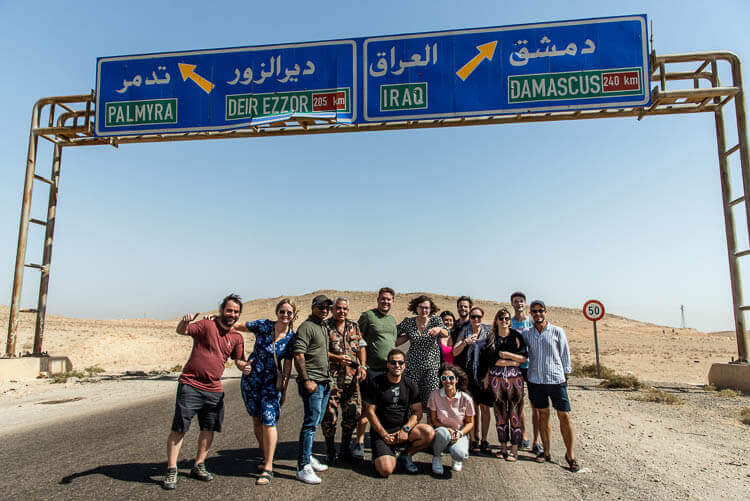
Join a group of like-minded travelers in our next scheduled tour in Syria on:
August 11th to 17th, 2024learn morePrior to 2010, Syria was one of the most touristic countries in the Middle East, receiving an average of more than 8 million tourists per year.
In 2011, however, an unfortunate war made Syria one of the most dangerous countries in the world, preventing travelers from venturing into an amazing destination with epic places to visit.
Nevertheless, few travelers know that, after several years of darkness, Syria is welcoming tourists again, and the reason is that some parts of the country are gaining significant stability, hence becoming safer for travelers.
This is a comprehensive analysis of how safe is Syria from a tourism perspective. From the latest updates to safety tips and a compelling region breakdown, Against the Compass is always your source.
Why travel to Syria with Against the Compass?
Our honest review of what is it like to visit Syria with Against the Compass, what is it that makes us unique, as well as testimonials from some of our customers.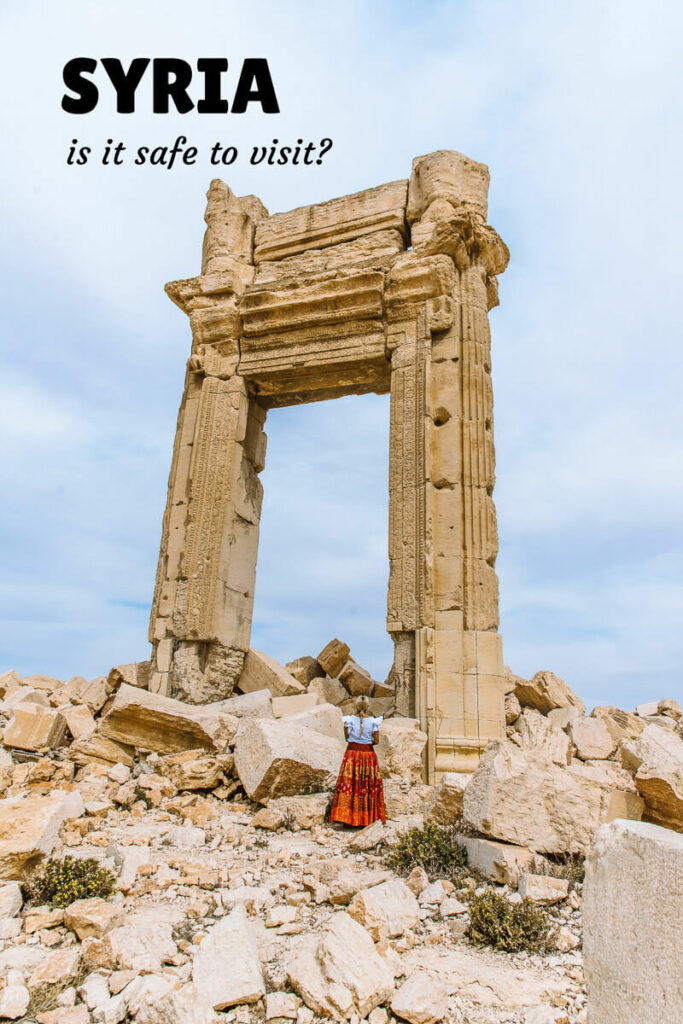
In this Syria safety guide you will find:
Table of ContentsSyria todayTravel insuranceSyria ToursTravel adviceMy personal experienceSafety by regionSafety tipsSolo female travelIs it safe for Americans?ConclusionMore informationour recommended travel insurance for Syria
IATI Insurance is one of the very few that covers travel in Syria.GET 5% DISCOUNT HERELatest update: Is Syria safe now?
In March 2011, the Syrian Government decided to suppress the Arab Spring protests violently, an action that unleashed an armed conflict that later became a bloody civil war between tonnes of different groups supported by different foreign forces, including the USA, Iran, Russia, and Turkey.
With several million refugees and hundreds of thousands of dead civilians, the Syrian war is considered to be the worst humanitarian crisis in the 21st century, the legacy of which has left a country divided.
Today, the war is nearly over in many parts of Syria, but it has become a fragmented country made of different regions controlled by distinct armed and ethnic groups, including Al-Nusra, the Free Syrian Army, the Kurds, the Islamic State – composed of sleeping cells mostly hiding and operating in the Syrian desert – and even Turkey and the USA.
The areas controlled by the Government are safe to visit
Honestly speaking, Syria is still hugely chaotic, a real mess but, surprisingly, those areas controlled by the Syrian Government (Bashar al-Assad) are actually enjoying certain stability, safety-wise speaking, and that is why the Government decided to open their territories to foreign tourism.
These Government-controlled territories comprise practically all of west Syria, including popular places such as Damascus, Aleppo, Homs, Krak de Chevaliers, anywhere along the Mediterranean coast and also Palmyra.
Those cities are pretty safe nowadays, open to all travelers with a valid visa, which you can only obtain through a tour operator.
Is Syria safe due to the Israel-Gaza war in 2024?
Back in October 2023, when the war in Gaza started, the situation across several countries in the Middle East was full of uncertainty and highly unstable.
With more than a few war fronts opened in neighboring countries such as Syria or Iraq, nobody knew what this war could lead to, the reason why we decided to temporarily suspend all our Syria tours.
However, life in Syria goes on as usual, markets keep being at their fullest and fortunately, all reciprocal attacks between Israel and Syria have been exclusively targeting military areas, never civilians.
This is the reason why we are traveling back to Syria again.
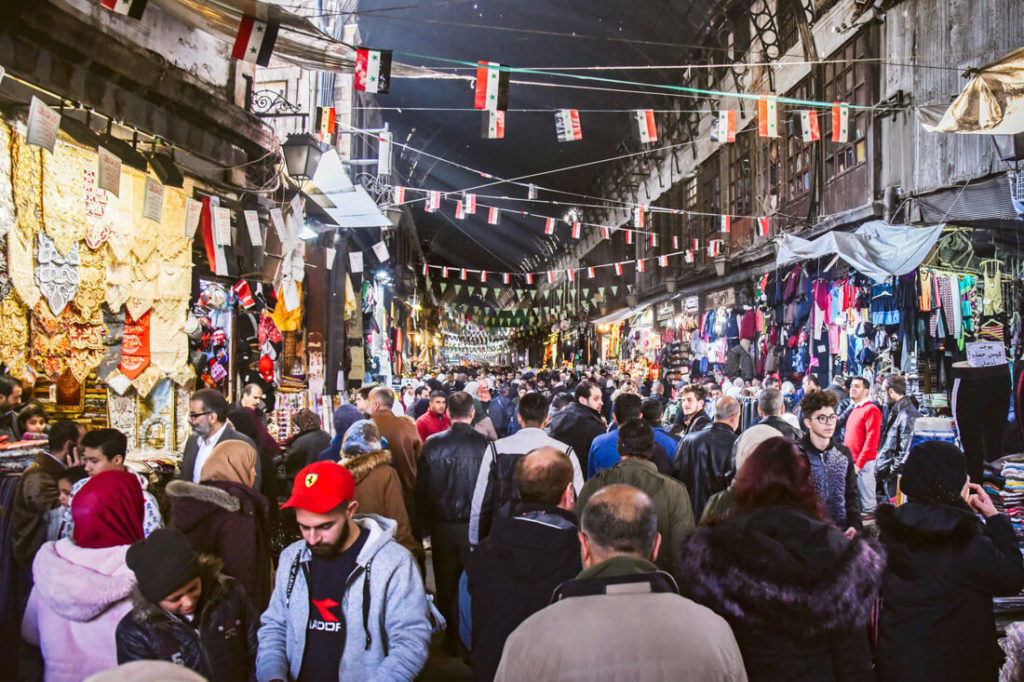
This is Damascus Souq, today, one of the safest places in Syria
Travel insurance for Syria
Like in Iran, because of all the sanctions, most travel insurance companies don’t provide cover for travel in Syria.The one that does, however, is IATI Insurance.They have loads of different plans for all types of travelers and the best of it is that the readers of this blog can get an exclusive 5% discount.BUY IT HERE TO GET YOUR DISCOUNTHow to sign up for a tour in Syria
The safest way to visit Syria is with a group and a certified guide who knows the latest security updates.
Our upcoming Syria Expeditions for 2024:
May 29th to Jun 5th, 2024 (8 days). SOLD OUTAug 11th to 17th, 2024 (7 days, Marmarita Carnival). APPLY NOWSep 15th to 27th, 2024 (13 days). APPLY NOWOct 13th to 20th, 2024 (8 days). APPLY NOWDec 23rd to 30th, 2024 (8 days). APPLY NOWLEARN MORE ABOUT OUR SYRIA TOURS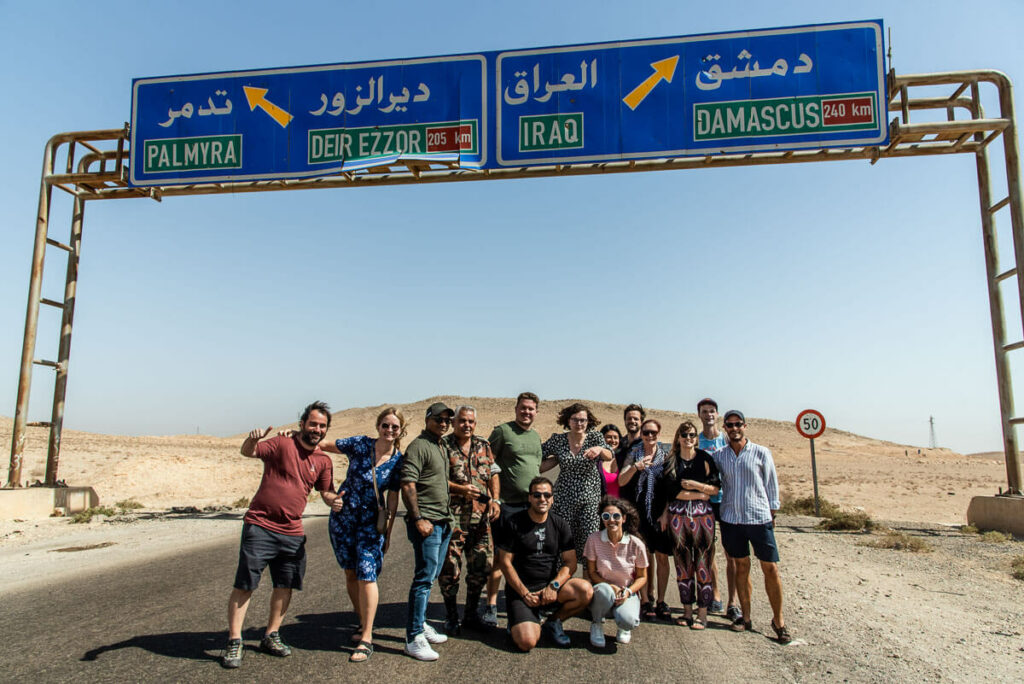
One of our last Syria groups
Is Syria safe to travel? A look into the Government’s advice
If we look into the Syria travel advice–, the FCDO advises against all travel to Syria, and claims that foreigners should leave by any practical means.
Is Syria dangerous for tourists?
The FCDO say that the situation in Syria remains volatile and dangerous, which is partly true, but only in those regions where the Government doesn’t have any sort of control, especially in the eastern part of the country, an area absolutely off-limits to tourists.
Regardless of your feelings about the current Syrian Government – we are not here to discuss politics – the areas controlled by them are currently safe to travel to, and no Syrian living in that part of Syria will tell you otherwise.
As I always mention in similar safety reports, there is always a certain logic behind the FCDO travel advice, but it barely relates to the actual reality and is typically based on unlikely worst-case scenarios.
That’s why, instead of trusting their over-cautious analysis, do talk to Syrians living in Damascus or Aleppo – not abroad – and travelers who have recently been there as well. You are likely to hear an opinion that doesn’t differ much from what you find in this Syria travel blog.
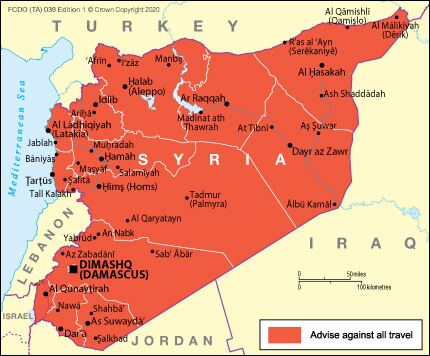
Travel advice for Syria according to FCDO
How safe is traveling to Syria from my personal experience
Since the beginning of the war, I have visited Syria three times, and I can only say positive things about it.
The people
On the one hand, Syrians are genuinely kind and happy to see tourists because they are a clear sign that Syria is becoming safer as a country, plus let’s not forget that tourism used to be an essential part of Syria’s economy.
Security in Syria
On the other hand, I can affirm that the security situation between 2018 and 2022 has drastically improved and proof of it is that, back in 2018, going through checkpoints was more way tedious than it is today.
In 2018, road checkpoints used to take ages and in Damascus, I remember the Syrian Army checking my backpack every now and then. In 2022, however, we managed to get through all checkpoints fairly quickly, making everything seem much more relaxed.
A curious fact to mention is that in 2022, the only checkpoint where I was asked for my passport was the Bosra checkpoint, which isn’t controlled by the Government but by the Free Syrian Army (FSA).
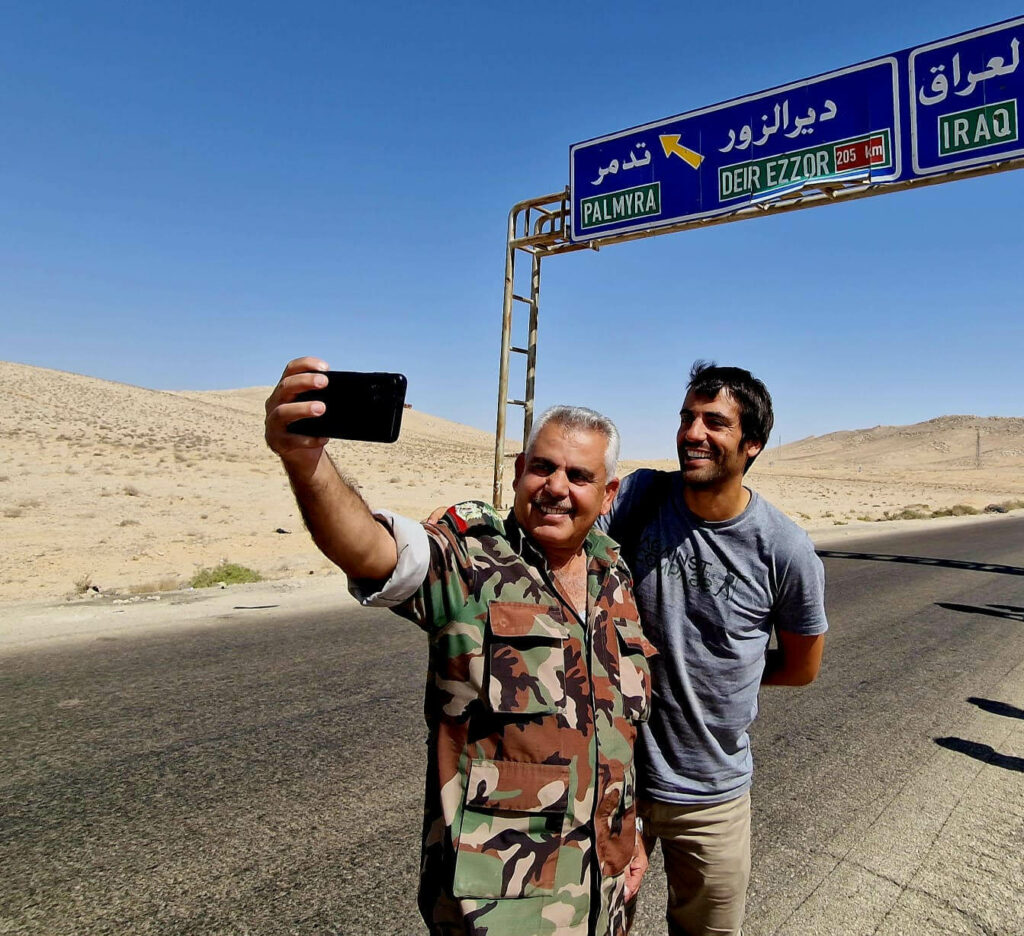
With a member of the Syrian Army, escorting the group on the way to Palmyra
Is life back to normality in Syria?
Despite the abundance of ghost towns and destroyed buildings, life in Western Syria is slowly coming back to normality, visible in the overpacked souks and restaurants of Damascus, for example.
Homs and Aleppo have struggled much more than Damascus but a lot of rebuilding is ongoing, shops are reopening and, very slowly, Syrians are moving back to their hometowns.
It will take a long time for Syria to recover the beautiful life from before 2010, especially because half of the people fled abroad, plus there isn’t any money to rebuild the numerous destroyed buildings.
Nevertheless, the simple fact that this back-to-normal process has already started can only mean that Syria is becoming safer and that there is hope.
Personally, I found Venezuela extremely more dangerous than anywhere I’ve been in Syria.
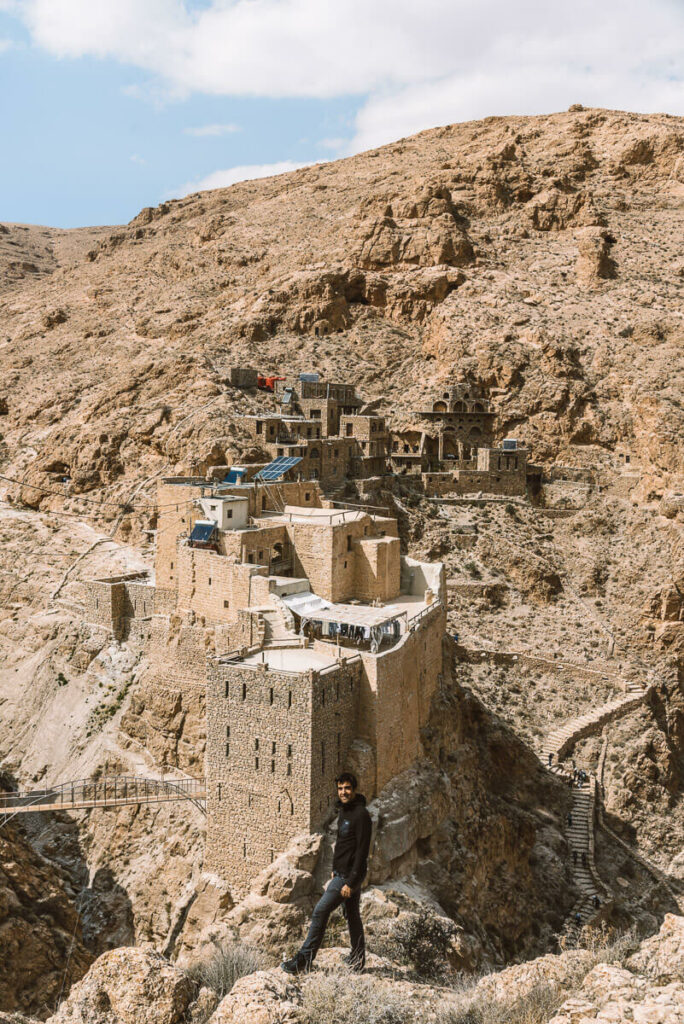
Enjoying in Mar Musa monastery, one of the safest parts of Syria
Which parts of Syria are safe to visit?
Read: 1-week safe itinerary for SyriaHere’s an overview of where in Syria is safe to travel.
1 – Safe regions to visit in Syria
Is any part of Syria safe? – some people wonder. As I mentioned before, the safe areas to visit in Syria are those which are controlled by the Government.
Is Damascus safe?
Officially, the capital has always been one of the safest places in Syria – relatively speaking. While it’s true that the outskirts of the city are heavily bombed, both the old city and the new part of town are untouched, and the different streets and souks are back to life.
Actually, all travelers are absolutely wowed by how ordinary everything seems to be. Today, walking around Damascus on your own is completely safe.

Damascus is a safe place to travel in Syria
Is Aleppo safe?
Liberated in 2017 from Al Nusra, the old city of Aleppo was largely destroyed.
People say that, before the crisis, Aleppo used to have the most beautiful souk in the Middle East. Sadly, most shops are closed nowadays but there is a lot of rebuilding going on and, compared to 2018, many small, family-owned businesses have begun to pop up.
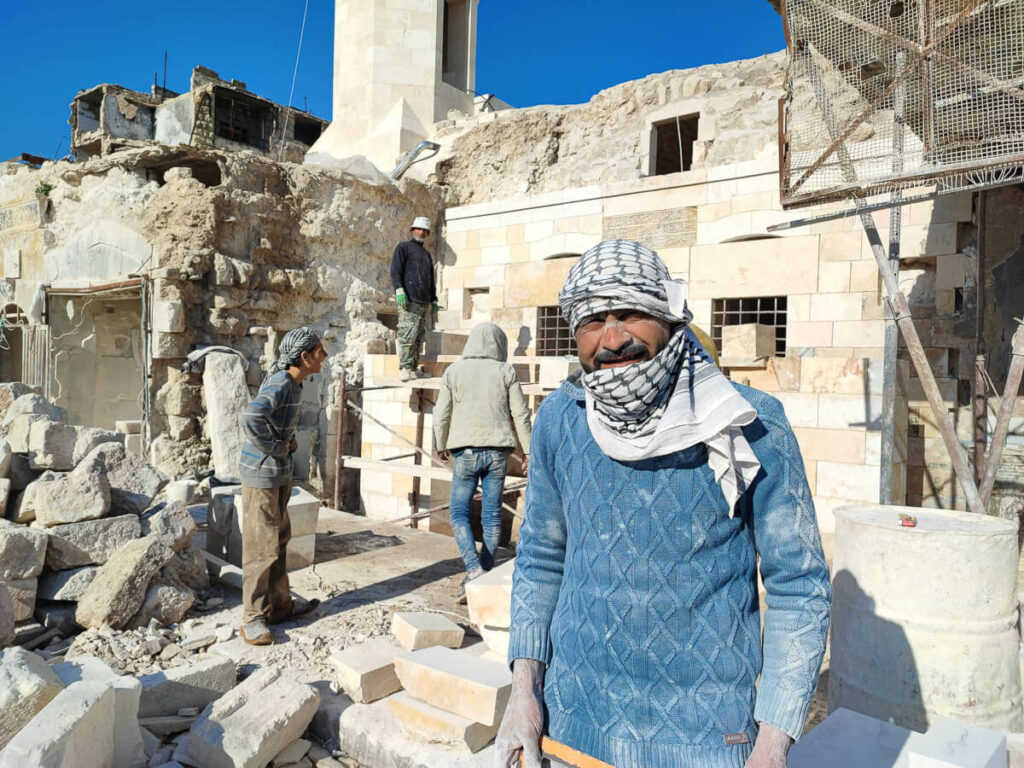
Living history – A Syrian man rebuilding a destroyed mosque in Aleppo
Is Homs safe?
By far, Homs was the most affected city by the war, nearly half of it being completely destroyed.
When I first visited it in 2018, it was a deplorable, ghost town. The souk was gone and I could barely see anyone strolling the streets.
But during my second visit in 2022, the souk had been rebuilt and some parts of the city center felt relatively busy. But again, it will take ages for Homs to come back to its original beauty, since many of its districts are today nothing but pure rubble.
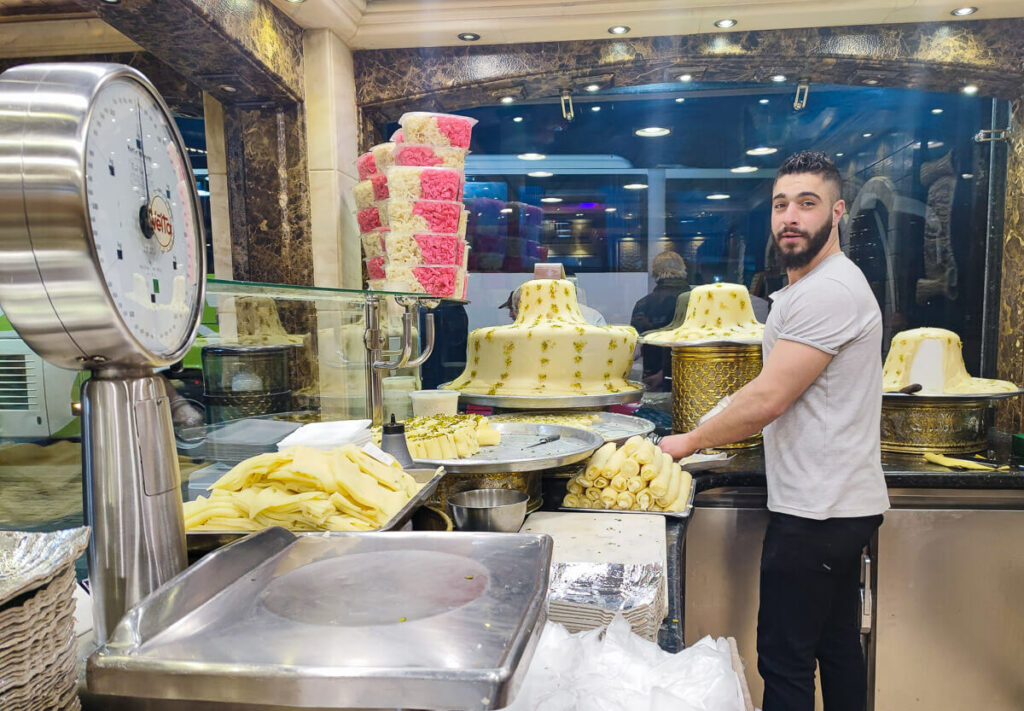
A sweets shop in Homs
Is Krak de Chevaliers safe?
Krak de Chevaliers is a Crusader fortress and one of the most well-preserved medieval castles in the world. It used to be a major tourist attraction but during the crisis, it was taken by a branch of Al-Qaeda named Al Nusra before the Syrian Army took it back.
Luckily, the castle remained untouched, and foreign visitors are allowed to visit it again.
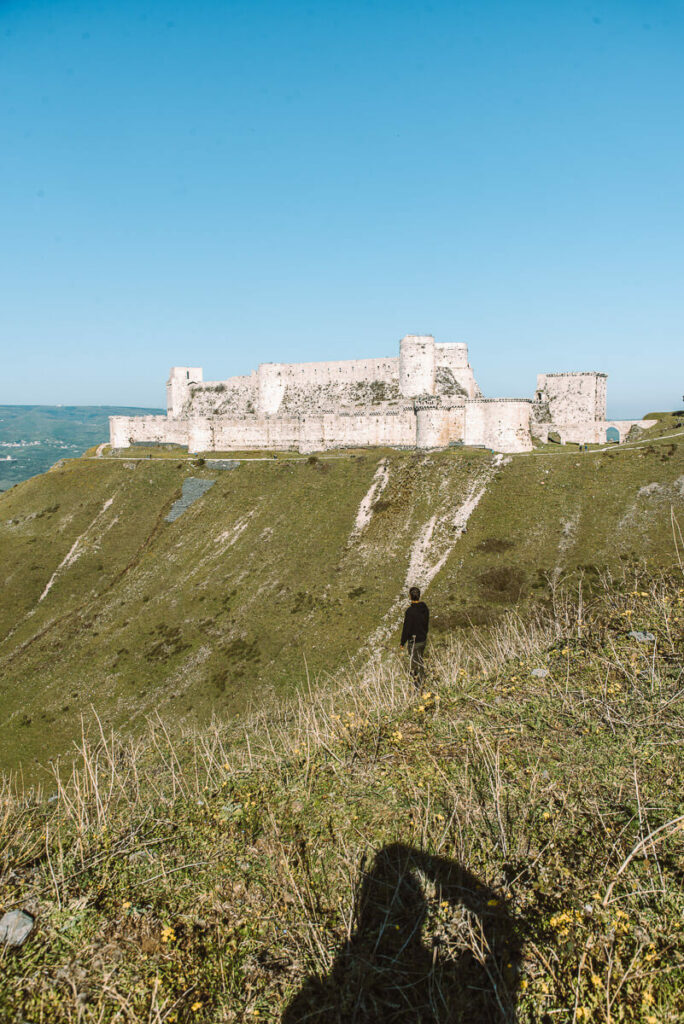
Krak de Chevaliers
Is Maaloula safe?
Infamous for being the place where those nuns were kidnapped by Al Nusra, Maaloula is a historic, Christian town that was also taken by the jihadists in 2013, and recovered during the battle of Maaloula.
You can still see some destruction but pretty much all churches and monasteries have been rebuilt and Maaloula is welcoming tourists again.
More safe places to visit in Syria
There are more places in Syria that are safe to visit:
Hama: the city with the 17 noriasAl Mishtaya and Marmarita: lovely Christian villages close to KrakSidnaya: Christian town close to MaaloulaTartous and Latakia: the two main coastal citiesArwad: the only inhabited island in Syria
Hama is one of the safest places to visit in Syria
2 – Relatively safe areas to visit in Syria
The following places are actually safe to visit but they have some particularities:
Is Palmyra safe?
The city and archaeological site of Palmyra lie almost 300km east of Damascus. It was taken by ISIS on two separate occasions (2014 and 2016). They blew up the Temple of Bel, but the site is huge and most of its structures are still standing.
The reason why Palmyra is in the relatively-safe section is that ISIS cells are not that far away, and a few attacks have been reported – always targeting the army – along the road that takes you to Palmyra.
The situation, however, is calmer now, there is a crazy amount of security along the way, plus all tourists must be escorted by an army member.
The archaeological site of Palmyra is guarded by the Russian Army. They are based in Qalaat Fakhr ad-Din al-Maani (Palmyra Castle), the fortress that overlooks the ruins, and a former tourist spot for watching sunset.
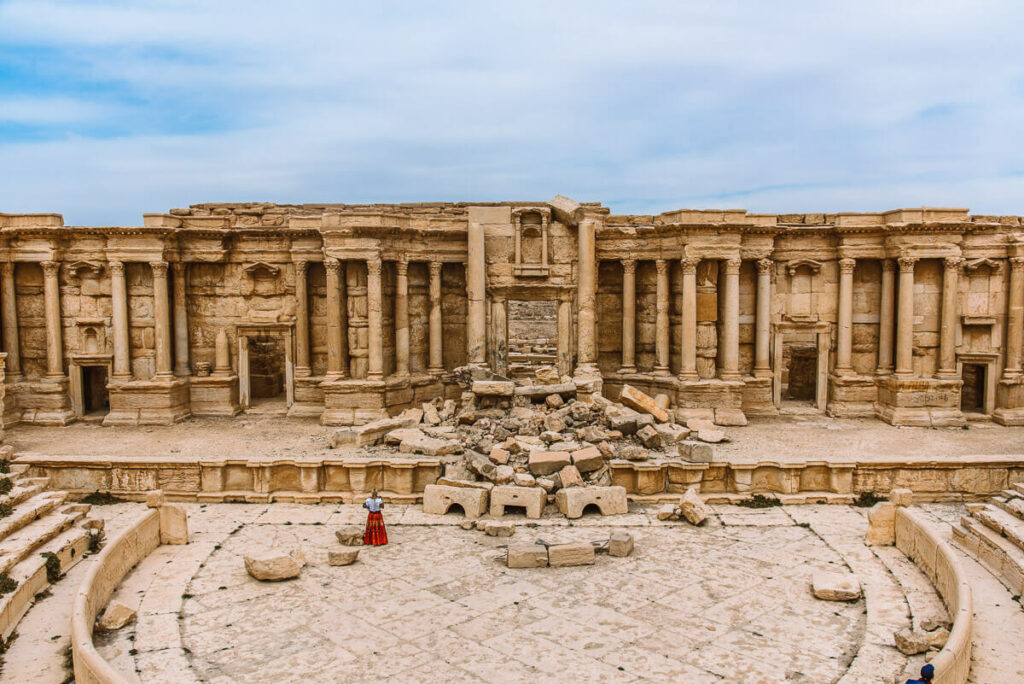
The Roman site of Palmyra is safe and possible to visit
Is Bosra safe?
Bosra is a southern city located close to the border with Jordan.
It’s a peaceful town, and pretty much the only safe place to visit that isn’t controlled by the Syrian Government but by the Free Syrian Army, an armed group representing the Syrian people who oppose the Syrian regime.
The FSA had an important role in fighting the Syrian Government during the war but now, they are trying to make peace with each other and, in exchange for controlling that territory, they agreed to allow the Russian army’s presence.
Bosra is safe to visit but it’s quite sensitive and most travelers venture here just to visit the Roman theater.
3 – Dangerous areas to visit in Syria
The dangerous regions to visit in Syria have one thing in common, which is that you can’t visit them, even if you wanted to.
Is Idlib safe?
Being almost an enclave within the Government-controlled west part of Syria, the city of Idlib is an area dominated by Al Nusra. Their domination, however, is merely symbolic because it is actually occupied by Turkey, for real.
No kidding, when you get close to Idlib (and you will on your way to Aleppo), you will receive a Turkish mobile network, along with an SMS literally saying Welcome to Turkey.
Nobody knows which kind of deal is going on there but, in my understanding, it seems the Government has stopped fighting for Idlib, and Turkey began annexing it. In Idlib, they don’t use the Syrian Lira anymore but the Turkish, and their inhabitants are not allowed to enter Syria but they can enter Turkey. It’s not on the Western news, nobody talks about it, but it’s real.
In any case, on your way to Aleppo, despite being so close to Idlib, the situation is safe because the road is controlled by the Government, and they don’t even allow cars to stop.
Is Raqa safe?
The former capital of ISIS is absolutely off-limits to tourists.
While in Syria, I tried to figure out the current situation of Raqa but never managed to get a convincing response. Apparently, part of Raqa province is under the Government’s control, while the rest is under that of the Kurdish forces. Some people claim, nevertheless, that it’s still a dangerous place because ISIS sleeping cells are still a thing there.
Is Rojava safe?
Rojava – officially named the Autonomous Administration of North and East Syria – is a region of Syria that could be essentially understood as Syrian Kurdistan. It gained its autonomy as a result of several battles during the war, and here you can read a fantastic explanation of it.
Rojava is still a turbulent region with on and off conflict. For example, in February 2022, ISIS committed an attack on al-Sina Prison, located in a city within Rojava.
In any case, Rojava is absolutely off-limits to tourists now.

A tank from the Syrian army in Bosra
Tips: How to stay safe in Syria
Travel with a guide and a group
Traveling with a group and a local guide who knows the latest security updates will make your Syria trip much safer.In any case, in order to get a visa for Syria, you must travel with a group and for that, Against the Compass has several scheduled groups per year.Our upcoming Syria EXPEDITIONS
May 29th to Jun 5th, 2024 (8 days). SOLD OUTAug 11th to 17th, 2024 (7 days, Marmarita Carnival). APPLY NOWSep 15th to 27th, 2024 (13 days). APPLY NOWOct 13th to 20th, 2024 (8 days). APPLY NOWDec 23rd to 30th, 2024 (8 days). APPLY NOWLEARN MORE ABOUT OUR SYRIA TOURS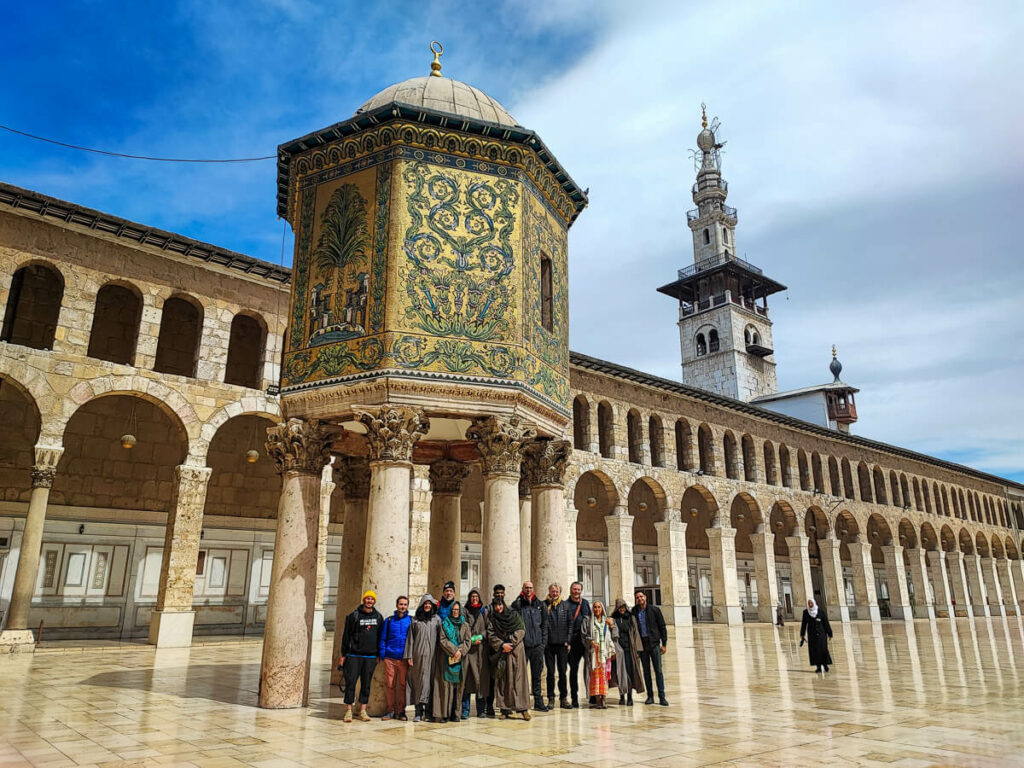
Damascus with the group
Use travel insurance that covers Syria
In a country like Syria, where safety is the #1 priority, traveling with proper insurance is a must.IATI Insurance is one of the very few that covers travel in Syria + COVID-19.5% discount if purchasing via this linkDon’t talk about politics
Locals are not allowed to say anything bad about the Government, and neither are foreigners.According to many Syrians, walls in Syria have ears, so I recommend staying away from political conversations.Don’t venture into sensitive areas
In the unlikely event that you are wandering around Syria on your own, don’t go to sensitive areas, and not only for your safety, but also because you risk getting arrested, as happened to a certain backpacker who I prefer not to name. Basically, he managed to reach the front between the Government and I don’t know which other group, a foolish act that got him arrested for a week.Is Syria safe to visit for solo female travelers?
Is Syria a safe country for women travelers?
Similar to neighboring Lebanon, Syria is an ethnically, religiously, and culturally diverse country, also home to a large secular population and a lot of Christians.
What I want to say is that Syrians are used to dealing with all sorts of people, meaning that bumping into a bunch of liberal women strolling down the streets of Damascus isn’t a rare thing to see so, unless you are visiting pretty conservative areas, you can dress up as you please, relatively speaking, of course.
Moreover, while it’s true that many people do fast during Ramadan, many Muslims don’t, plus a lot of restaurants keep their doors open, and the reason is that the relatively secular population in Syria is quite large.
Traveling as a woman in Syria is, obviously, more challenging than if you are a man – like in any other country – but what I can tell you is that popular destinations such as Morocco, Egypt or even Jordan are way more challenging than Syria, from a solo woman perspective.
In any case, solo travel isn’t really allowed in Syria, but you must be with a local guide.
Is traveling to Syria safe for Americans?
Syrians are generally kind-hearted people who don’t make judgments based on nationalities.
While it’s true that many Syrians blame – partly – the USA for what happened in the country recently, they also know that American tourists have nothing to do with the US Government and that they visit Syria just to learn about the conflict, meet beautiful Syrians and visit all their historical gems.
If you want to know how to travel to Syria as an American, check our visa guide.
Conclusion: Is Syria safe for tourists?
It’s important to keep in mind that the situation in the areas controlled by the Syrian Government are not entirely safe, but relatively safe, so always pay attention to your surroundings and do your own research before going there. Against the Compass is not responsible for any potential, unfortunate event related to the current crisis.
More information for traveling safely in Syria

In my Travel Resources Page you can find the list of all the sites and services I use to book hotels, tours, travel insurance and more.
Remember to check our upcoming tours: Syria Tours run by Against the Compass
ll our guides to SyriaSyria Travel GuideTravel Guide to AleppoSyria ItineraryCheck more safety guides
Is Afghanistan Safe?Is Iran Safe?Is Iraq Safe?Is Lebanon Safe?Is Mali Safe?Is Mauritania Safe?Is Middle East Safe?Is Oman Safe?Is Pakistan Safe?Is Sudan Safe?Is Tunisia Safe?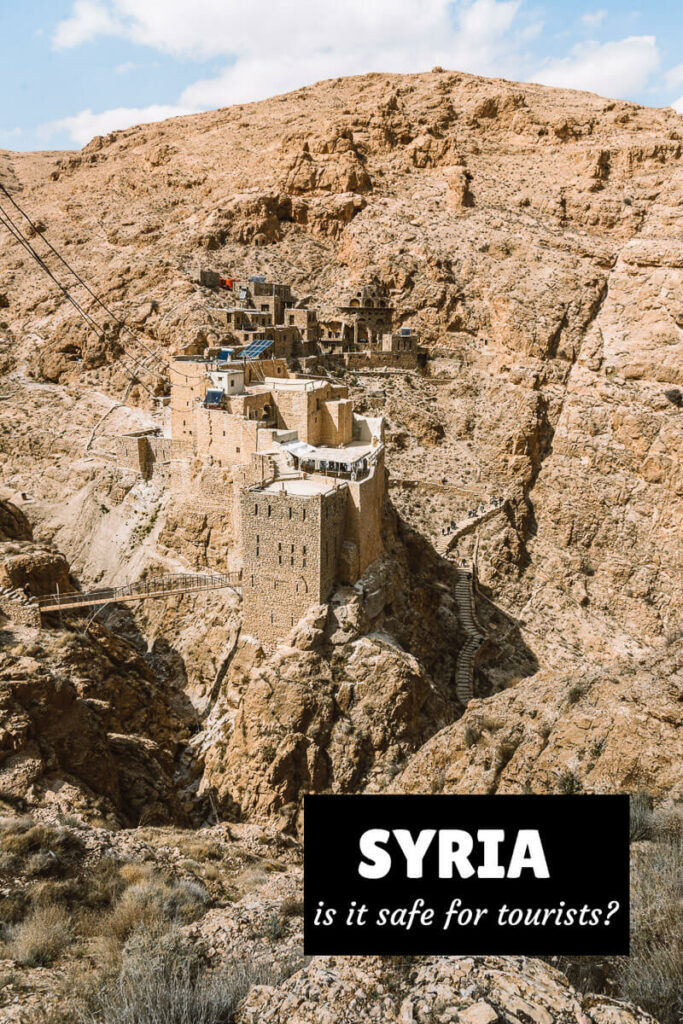
-
By: Joan Torres
Title: Is Syria safe to visit in 2024?
Sourced From: againstthecompass.com/en/syria-safety/
Published Date: Wed, 13 Mar 2024 09:53:00 +0000











